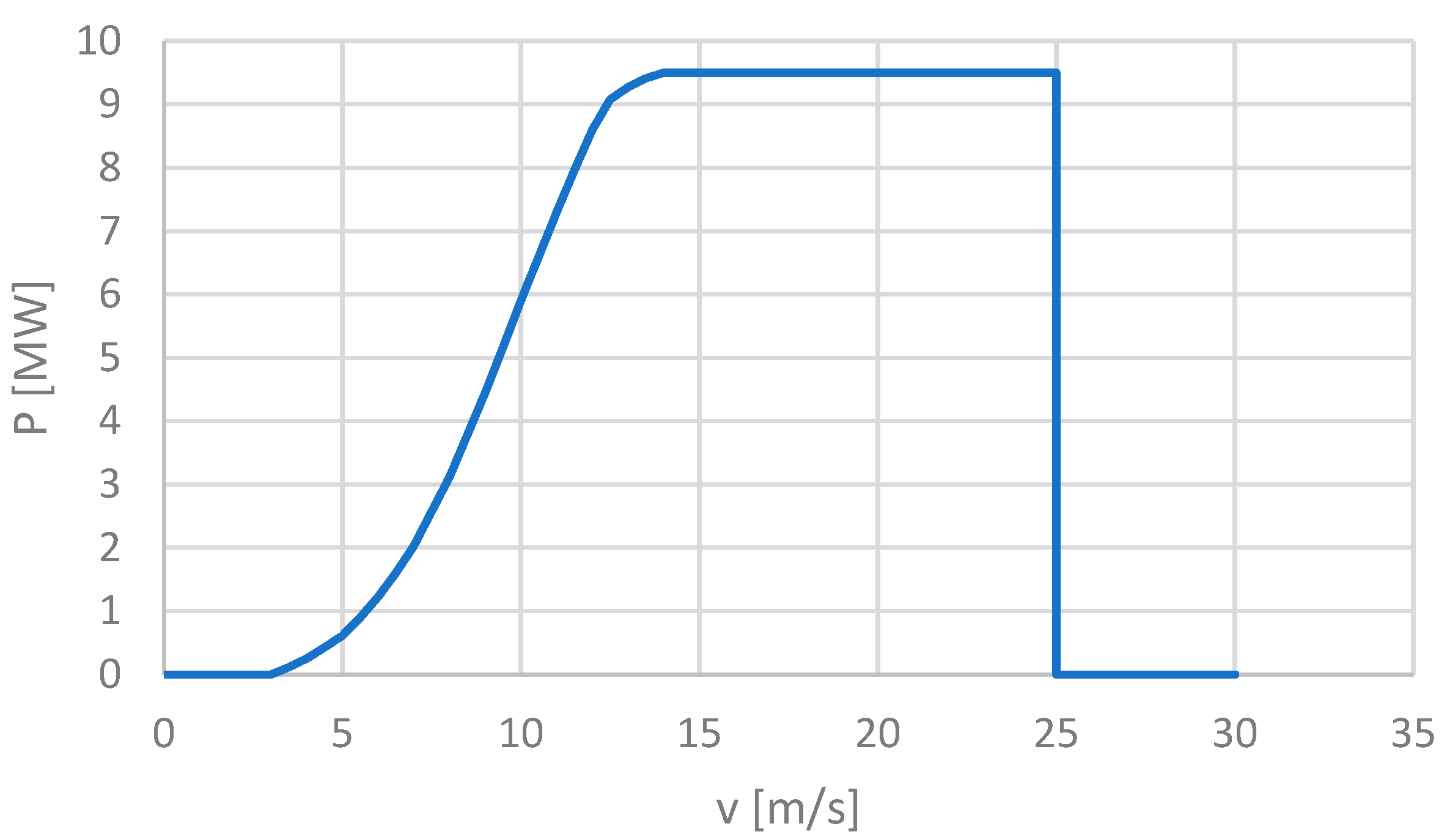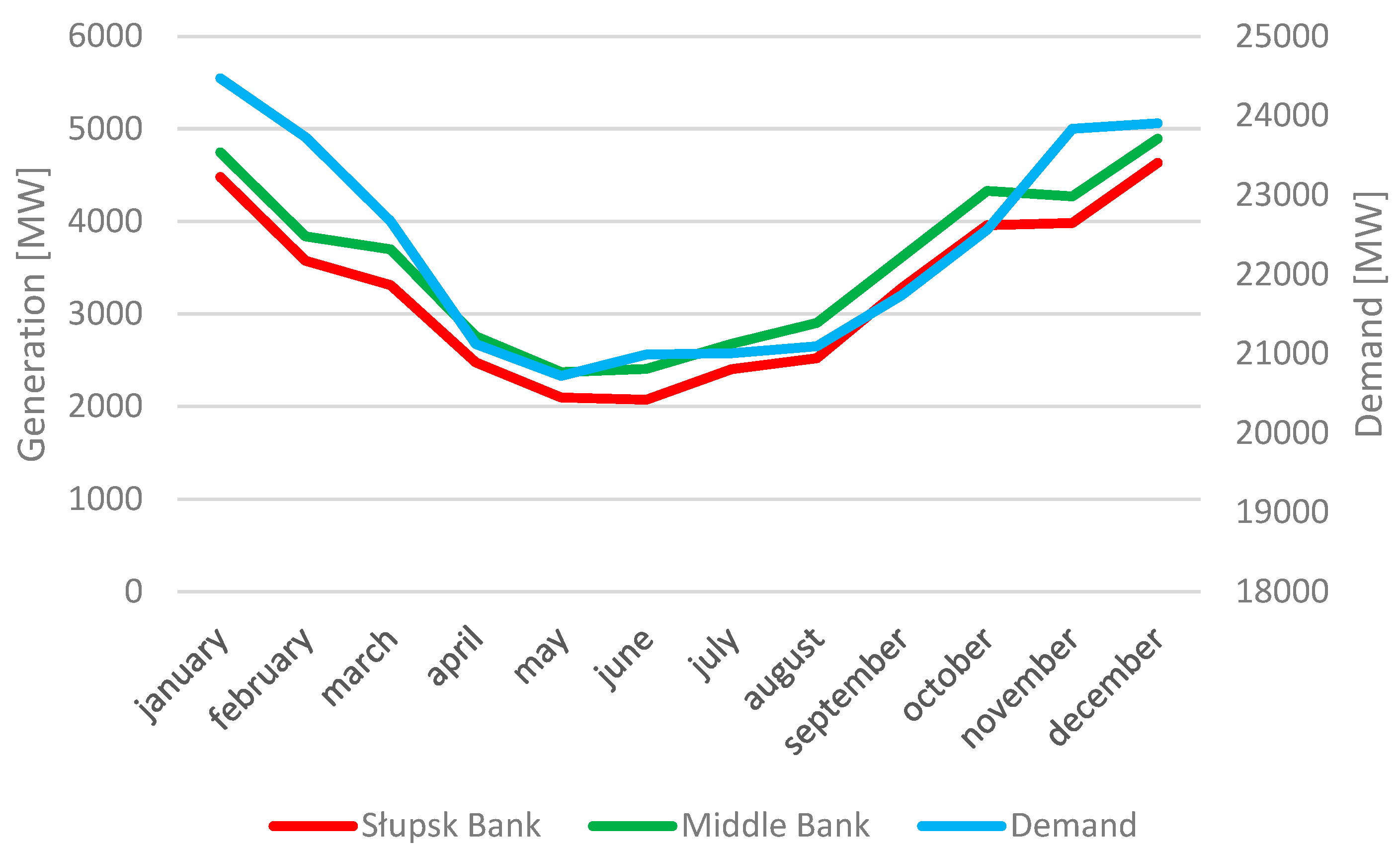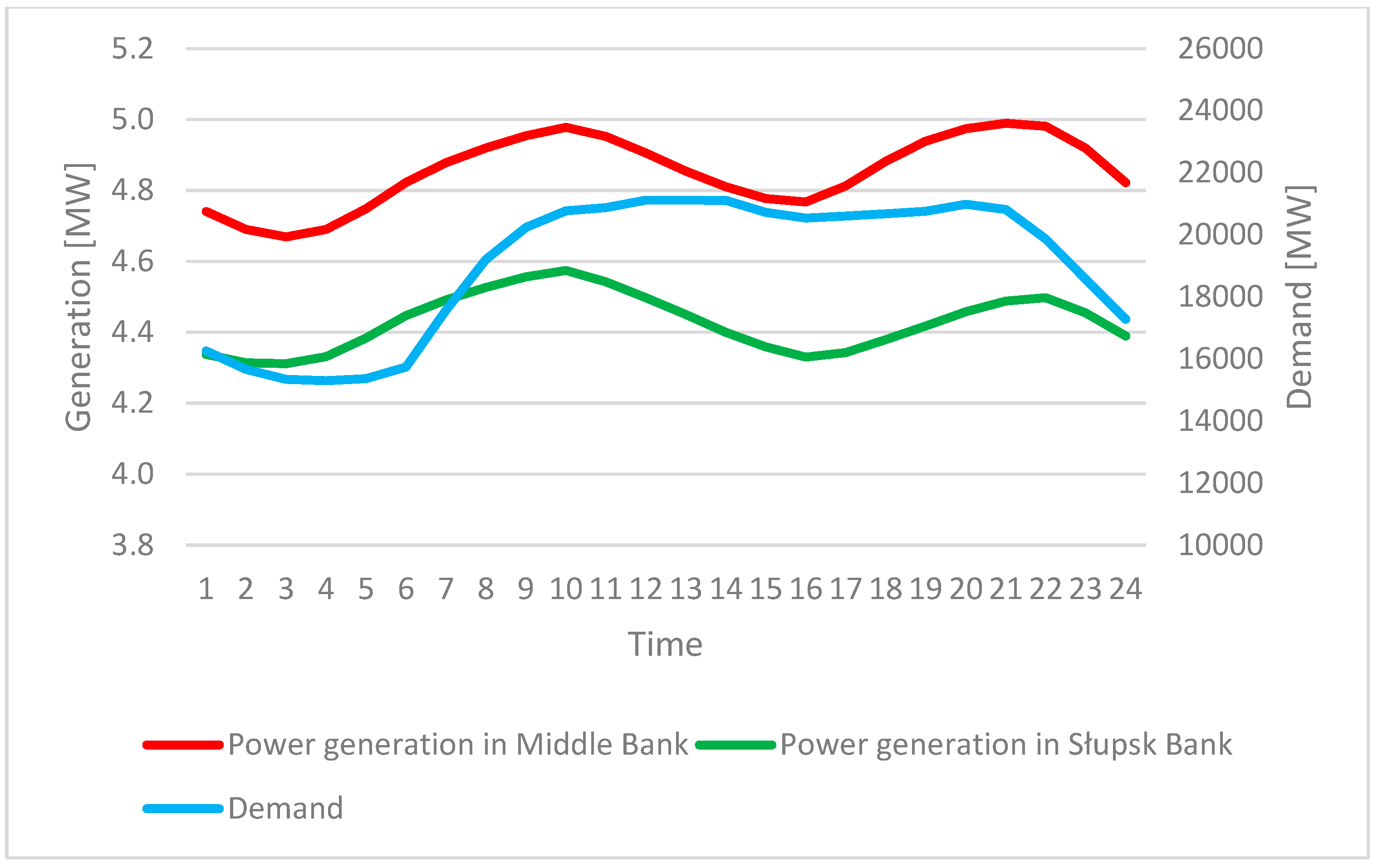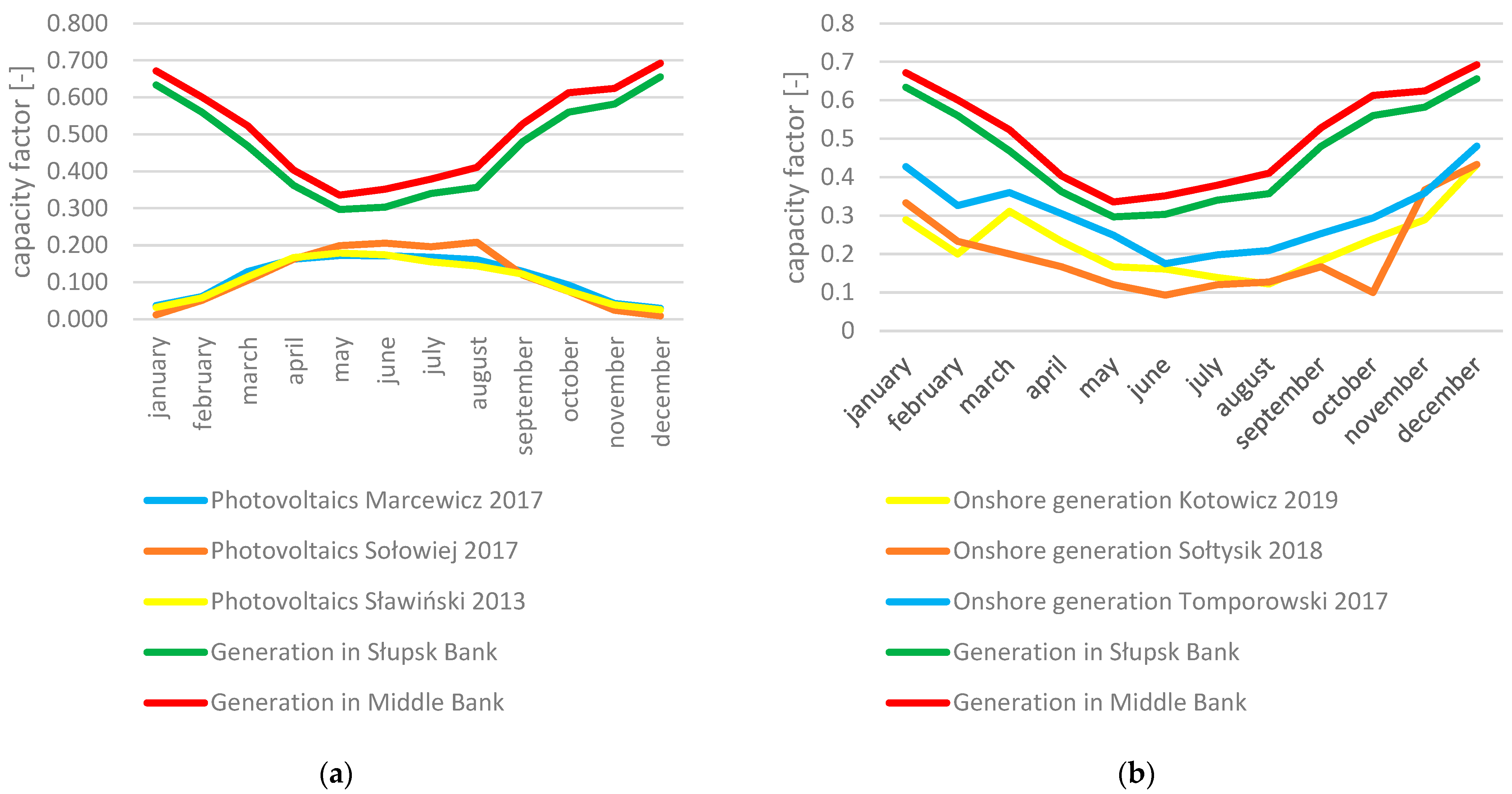1. Introduction
The demand for electricity in Poland is constantly growing. Forecasts contained in government documents indicate that this growth will continue and between 2019 and 2040 the demand will increase by over 20% [
1,
2]. The peak power demand will also increase. In recent years, the distribution of energy demand in individual months of the year has also been changing. More and more energy is consumed in the summer, which narrows the difference between summer and winter [
3]. This shift is driven in large part by the increasing use of air conditioning and the development of data management centres that require efficient HVAC systems [
4].
Polish electricity generation is one of the most coal-dependent in Europe. According to the data of the transmission network operator in Poland, in 2020 over 71% of the energy generated in Poland came from professional hard coal and lignite power plants [
3]. Due to the need to decarbonise the energy sector, there is a need to replace carbon sources with zero-emission sources. One of the sources with the greatest potential is offshore wind farms (OWF). The maximum potential in terms of Polish OWF is estimated at 28 GW [
5]. However, this would require the use of areas of the Baltic Sea that are so deep that only floating farms can be built there. For this reason, Flaszyński et al. estimate the theoretical potential at the level of 18 GW [
6], and government documents provide for the development of 11 GW by 2040 [
1], which corresponds to over 22% of the installed capacity in the Polish system in 2020. Despite the fact that there is a great potential in OWF in Poland, there is no OWF constructed at the moment. Most developed projects have now been in the phase of choosing the turbines. The projects that have been developing in Poland will be located on two banks: Słupsk Bank and Middle Bank [
7].
OWF is characterized by higher energy generation and stability than onshore farms. They also use other types of turbines (OWT). OWT has higher rated powers, larger diameters of the circle delineated by the rotor blades and are most often higher than shore-based turbines [
8,
9]. Due to higher wind speeds at the sea, OWT is sometimes designed to operate at wind speeds greater than 25 m/s, which is the limit value for onshore turbines [
10]. However, they are much more expensive and more complicated in design and implementation than onshore turbines.
Despite their advantages, OWFs are stochastic and seasonally variable sources. Therefore, it is necessary to determine their impact on the country’s power system, as they will constitute a significant part of the system. An important aspect of the OWF’s work, which receives less attention, is the correlation of generation with energy demand. This is important due to the fact that different areas are characterized by different daily, monthly and inter-annual variability [
11]. OWF can both contribute to covering the demand and reducing the dependence of generation on sources emitting CO
2 (in the case of a high positive correlation with the demand), and cause in-demand valleys, where it will be necessary to switch off conventional units, and in peaks, it will be necessary to restart them (with a negative correlation).
The above considerations were the basis for the analysis of literature reports indicating several trends in research related to the use of renewable energy sources, in particular OWF.
The first of these trends is the modelling of RES systems. In this area, dos Santos et al. [
12] point to the necessity to analyze power flows in power grids and to build models of these grids for the purpose of forecasting their further expansion. In turn, Zhang et al. [
13] show the effectiveness of using multi-objective optimization as a method to improve the efficiency of using electricity generated by OWF. The work of Zhao et al. [
14] concerns model studies of the use of nuclear and wind power plants in the power system so that by deploying new wind farms (WF) it is possible to gradually phase out nuclear power plants as those with a higher risk of a serious accident and replace them with cheaper WF. Mueller [
15] points to the role of demand-side management (DSM) as a method facilitating the integration of RES with the power system and a means to manage overproduction by RES. Research by Koivisto et al. [
16,
17] relate to the analysis of the use of onshore and offshore WF and photovoltaic (PV) systems in Northern Europe. The conducted research has shown that modern wind turbines significantly reduce the variability of electricity generation in complex systems. The work of Mikulik et al. [
18] concerns the modelling of the net load variability due to the diversifying share of distributed sources (wind and solar). On the other hand, Pluta et al. [
19] focus on planning the transition from coal-based to RES-based energy in such a way as to minimize the potentially significant increase in electricity prices. One such way is DSM. Analyzes conducted by Kaczmarzewski et al. [
20] relate to the possibility of adjusting load profiles to electricity production by PV farms based on statistical data. Sun et al. [
21] indicate that active management of the power network brings benefits with the use of offshore RES, also in terms of the use of transmission lines. Acosta et al. [
22] propose a solution that is effective in managing the grid from RES, consisting of the construction of a coordinated system consisting of a controller that manages a wind farm at the same time, and energy storage in the form of battery banks and a DC line connecting them.
The next line of research is the stabilization of electricity supplies to the grid by RES, in particular WF, and environmental aspects. Wagner [
23] presents the necessity to use energy storage due to the instability of RES as a method of reducing CO
2 emissions in Germany. Sayigh [
24] deals with a similar topic for Malta. He points out that the combination of wind farms and pumped hydroelectric storage systems is an effective system stabilizing energy supply to the grid. On the other hand, Santos et al. [
25] analyze the economic and technical potential of the use of battery energy storage systems (BESS). They indicate that a well-managed BESS can increase the efficiency of a transmission system. Lu et al. [
26] show how in a practical way East China Grid Corporation can use pumped hydropower plants in its area of operation to stabilize the power system while reducing the share of nuclear power plants in electricity production.
Another trend that can be found in many publications deals directly with issues related to OWF and their role in meeting the demand for power and electricity. Silva [
27] points to the necessity to expand the network infrastructure, RES installations as close as possible to the places of demand and the necessity to supplement (stabilize production) RES by conventional power plants. This also affects the economy of energy production and the need for a flexible approach to controlling the operation of sources. Hu et al. [
28] indicate the need for optimal allocation and selection of OWF power. Curto et al. [
29] present the problems of using renewable energy sources, including OWF in Vietnam. Li et al. [
30] indicate the need to apply source-grid-load regulatory strategies, which, especially when applied to OWF, may lower the operating costs of the system and better use the potential of OWF. Klinger et al. [
31] prove that in the case of Germany, WF is the main element of the energy mix. Wang et al. [
32] show the analysis of simulation results, which prove that in the case of microgrids built from renewable sources (PV, WT) and battery storage, the use of a two-stage energy management system can significantly improve the efficiency of using these sources.
Eltamaly et al. [
33] proved that the hybrid energy system consisting of WT, PV, battery and diesel generator is a good combination for a smart grid. These types of networks together with the equivalent of the DRS optimization algorithm have a positive effect on reducing the cost of energy.
Alotabli et al. [
34] indicate that the use of renewable, hybrid sources of electricity is currently the best solution, especially when such a system is supplemented with energy storage. The authors conducted optimization, using an algorithm called the gradually reduced particles of particle swarm optimization, of the wind-solar system with pumped hydro energy storage for the area of Dumah Aljandal in the north of Saudi Arabia. These studies proved the superiority of using a pumped-storage system with a dynamic tariff demand to the other energy storage systems with flat-rate tariffs.
A number of works concern the analysis of OWF in a specific location. Pires et al. [
35] presents an analysis for the southern coast of Santa Catomina state in Brazil, Ortega et al. [
36] for northern California, Douville et al. [
37] for Oregon. The work of Bardenhage et al. [
38] concerns Japan, Al Hinai et al. [
39] analyze the case of Oman, and Roldan-Fernandez examines the impact of OWF on the energy market in Spain [
40].
The analysis of literature reports prompted the authors to analyze the OWF work in the southern Baltic Sea in the context of the cooperation of such sources with the Polish power system. We consider the lack of literature reports for the area in question regarding the correlation of the demand for power and energy and the considered plans for the construction of OWF in the analyzed area as a gap that can be filled by this article.
3. Results
3.1. Wind Conditions
The calculated average wind speeds at the measurement height, 10 m, and at the height of the turbine rotor, 110 m, are presented in
Table 4.
The calculated average annual wind speeds are included in the speed ranges obtained by Kostrzewa [
8] and Hahmann et al. [
51]. Also, the data from measurement masts in the German part of the Baltic Sea have similar values [
52].
Figure 2 shows the velocity histogram and the Weibull distribution plot. The parameter k was defined as 2.35.
The Weibull distribution with the given shape and scale parameters is very similar to the velocity histogram. This means that it can be used for further calculations of energy generation by offshore wind farms.
Better wind conditions (higher average wind speed and higher probability of higher wind speeds) are on the Central Bank than on the Słupsk Bank. The late autumn and winter months are characterized by much higher average wind speeds than the spring and summer months. The best wind conditions are in December and January, and the worst in May and June.
3.2. Power Generation in the V164-9.5MW Turbine
The forecasted energy generation in the turbines located on the Słupsk Bank and the Middle Bank is presented in
Table 5.
The results calculated and presented in
Table 5 do not consider the possible downtime of the turbines. They also assume immediate activation and generation of electricity after exceeding the extreme values of wind speed. It does not include the inertia of electricity generation following sudden changes in wind speed. As a result, the values obtained are very high and exceed the corresponding values of the turbines operating under real conditions.
Table 6 shows the average forecasted energy generation and the average power in individual months.
The highest average monthly power for a non-leap year is found in the late autumn and winter months (December, January, slightly less November and February), and the lowest in late spring (May and June). It is also visible that the average power of the turbines on the Central Bank is higher each month than on the Słupsk Bank. The decrease in average power between December and January and May and June amounted to over 50% on the Słupsk Bank and not much less on the Central Bank.
Table 7 shows the average power in each hour.
The obtained results indicate that for the turbines in both locations there is a difference in the average turbine power. More power is generated in the morning period, with a peak between 8–11 a.m., and in the evening, with a peak between 7 p.m. and 11 p.m. Power production valleys occur at night (24–4 p.m.) and in the afternoon (around 4 p.m.).
3.3. Correlation between Generation in OWF and Power Demand
The results of the correlation calculations between the generation in OWF and the demand for electric power in the monthly average values are presented in
Table 8.
The correlation coefficient R, for the period 2015–2019, is greater than 0.9 on both the Słupsk Bank and the Middle Bank. This proves that, according to the Guilford scale, there is a very strong positive correlation between the demand for power in individual months and the potential generation in OWT. On the other hand, the fit (characterized by the R2 coefficient) is good. Offshore wind farms produce more energy in the months of higher demand and less in the months of lower demand, so they can contribute to covering the peaks in demand.
There is a visible decrease in the value of the correlation coefficient and the determination coefficient in 2018–2019. It may be related to the changing distribution of power demand throughout the year and the increase in power demand in the summer months. However, the dependence according to Guilford is high. However, the fit for 2018–2019 is only satisfactory.
A chart comparing the average monthly demand with generation in OWF is shown in
Figure 3.
The graph showing both demand and production in individual turbines shows that they decrease in summer and reach their peak in winter. However, this is a comparison of multi-year values and may vary from year to year.
Table 9 presents the results of the correlation calculations between the power demand and the average hourly power generated in OWT.
Contrary to monthly averages of generation values, in the case of hourly averages, they cannot be considered strongly correlated with the demand. There is also a significant difference between the locations where the turbines will be located. The correlation between generation and demand according to the Guilford scale is positive and moderate. It is stronger in Middle Bank than in Słupsk Bank. The alignment is unsatisfactory in both cases. Therefore, it is not possible to present the dependence of generation on-demand in a linear manner. However, the fact that the correlation is positive indicates a good ability of the OWF to cover the demand.
A chart comparing the average hourly demand with generation in OWT is presented in
Figure 4.
The figure shows that offshore wind farms will produce less energy at night, which is correlated with demand. Also, during the evening rush, the generation in OWF will be larger, which is a positive feature of them. On the other hand, the morning peak of generation occurs before the peak of demand. Moreover, during the day, between 1 p.m. and 5 p.m., the generation valley follows, which is not correlated with the demand valley.
3.4. Correlation between Generation in OWF and Generation in Other Renewable Sources
Table 10 presents the correlation between the average monthly values of the capacity factor OWF and other renewable sources.
Generation in photovoltaic sources, regardless of geographic location, is strongly negatively correlated with generation in offshore wind farms. The correlation according to the Guilford scale is very high. The fit is very good in most cases, and in the case of PV installations in the southeast of Poland and OWT in the Central Bank, it is good. It follows that the more energy is produced in photovoltaic sources, the lower the generation potential in OWT. At the same time, the less energy is generated by solar farms, the more energy is generated by offshore wind farms. As a result, these are sources that complement each other well in terms of average monthly power generation.
The correlation between generation in offshore and onshore wind turbines is positive and very high. The fit determined by the coefficient of determination is satisfactory. Both offshore and onshore wind farms produce more energy during the same periods of the year. If production in onshore farms decreases, so does offshore production. However, it is not as strongly correlated as generation from photovoltaic farms and offshore wind farms.
Figure 5 shows the capacity factor changes during the year for OWF and other analyzed renewable sources.
The diagram shows that photovoltaic installations generate the highest power in summer and the minimum in winter. On the other hand, for offshore wind farms, the late autumn and winter months have the highest average power generation. Onshore wind farms generate the highest average power in the late fall months and winter (like offshore wind farms). On the other hand, in spring and summer, they are characterized by lower production. The lowest average power in onshore turbines occurs between June and September, and in the case of offshore turbines, between April and July.
4. Discussion
The obtained capacity factor for the OWT was 0.472–0.514. This is a very high value for wind turbines. The onshore wind turbines used in Poland so far are characterized by an average value of this coefficient at the level of 0.22 [
48], and in coastal areas, it reaches 0.34 [
53]. However, the value obtained is slightly higher than that currently characterizing wind turbines. Enevoldsen et al. [
54] indicate that the average capacity factor for the European OWT analyzed by them was 0.408. PGE Baltica experts estimate that OWF in the Polish sea will have a capacity factor of 0.40–0.45 [
6]. The experience of OWF in Great Britain shows that there are farms with a
cf index equal to or even higher than the designated one, while most farms have this index lower (the average in Great Britain is 0.397) [
55]. On the other hand, Dróżdż et al. [
56] indicate that the current estimated capacity factor for OWF is approximately 0.5. The overstatement of the capacity factor is caused by the failure time, rotor inertia or time necessary to start up the turbines, as mentioned in
Section 3.2. It is also caused by the fact that data from data reanalysis systems (such as MERRA-2, or the previous version of this system—MERRA) slightly overestimate the value of the capacity factor [
57].
The greatest energy production in OWT will occur in the winter months. It is related to higher wind speeds during this period. This is beneficial for the power system due to the positive correlation with the average energy demand and the negative correlation with the photovoltaic sources. A similar tendency is indicated in Great Britain, but there is no correlation with the peak demand in winter (in the periods of the highest demand in winter, OWF energy production is more often lower than the average generation) [
58]. Also in Scandinavia, Finland, and the Baltic states, there is an increased generation of electricity from wind power sources in winter [
59].
The average production of electricity in offshore wind farms during the day is the highest in the morning and evening hours, i.e., periods with peak demand. This correlation is visible both in Poland, as evidenced by the results obtained and presented in Tarełko’s [
60] work, and in other places in the world: the USA [
61] or northern Europe [
59]. However, the results obtained by Koivisto et al. [
59] indicate a much smaller correlation between generation and demand. The correlation is weak positive. This is due to the fact that due to the nature of the data used in this article (the data from MERRA-2 are reliable long-term data), no correlation was calculated for each hour of the year, but only for the mean values. It is necessary to carry out tests for real objects in the future or to make measurement masts measuring the wind speed in the Polish (southern) part of the Baltic Sea.
Energy production in offshore wind farms has a positive correlation with energy production in onshore farms. It is caused by the fact that the best wind conditions are in northern Poland, especially near the Baltic Sea. It causes that both offshore and onshore wind farms are located close to each other and wind conditions there are similar. Generation in OWF has a negative correlation with energy production in photovoltaic sources. In the winter and late autumn months, there are fewer sunny hours, and the radiation is smaller than in summer. It results in smaller energy production in those periods when generation in OWF is largest due to higher wind speeds. Similar results were obtained by Koivisto et al. [
59]. They analyzed energy production from seasonally changing renewable sources in Scandinavia, Finland and the Baltic states. However, due to the fact that in their work the average correlation between hourly generation was examined, and in this work the monthly average, the obtained correlation was smaller (correlation between offshore wind and onshore wind: 0.36, correlation between OWF and PV sources: −0.14) compared to the results obtained in this study (correlation between offshore and onshore wind: from 0.77 to 0.868, correlation between OWF and PV sources: from −0.936 to −0.970). In Poland, Jurasz et al. [
62] obtained a strong negative correlation between the monthly generation in photovoltaic and wind sources located on land but close to the sea (in Łeba). The mean monthly correlation coefficient was −0.85, which is very close to the results obtained in this study.
The generation of electricity in summer is much lower than that in the winter months. During this period, due to high temperatures and a decrease in the water level, generation is limited in hydroelectric power plants and thermal power plants with an open cooling circuit [
63]. The changing distribution of demand throughout the year (increased demand in summer) and the high correlation between onshore and offshore wind generation may make it impossible to maintain an appropriate level of reserves or even result in shortages of energy generation in the case of high saturation of the system with wind sources. In order to reduce this risk, photovoltaic sources might be used as their generation is strongly negatively correlated with generation in OWF. Cooperation between offshore wind and photovoltaic sources could be used to provide enough energy in the system in all months of the year.












